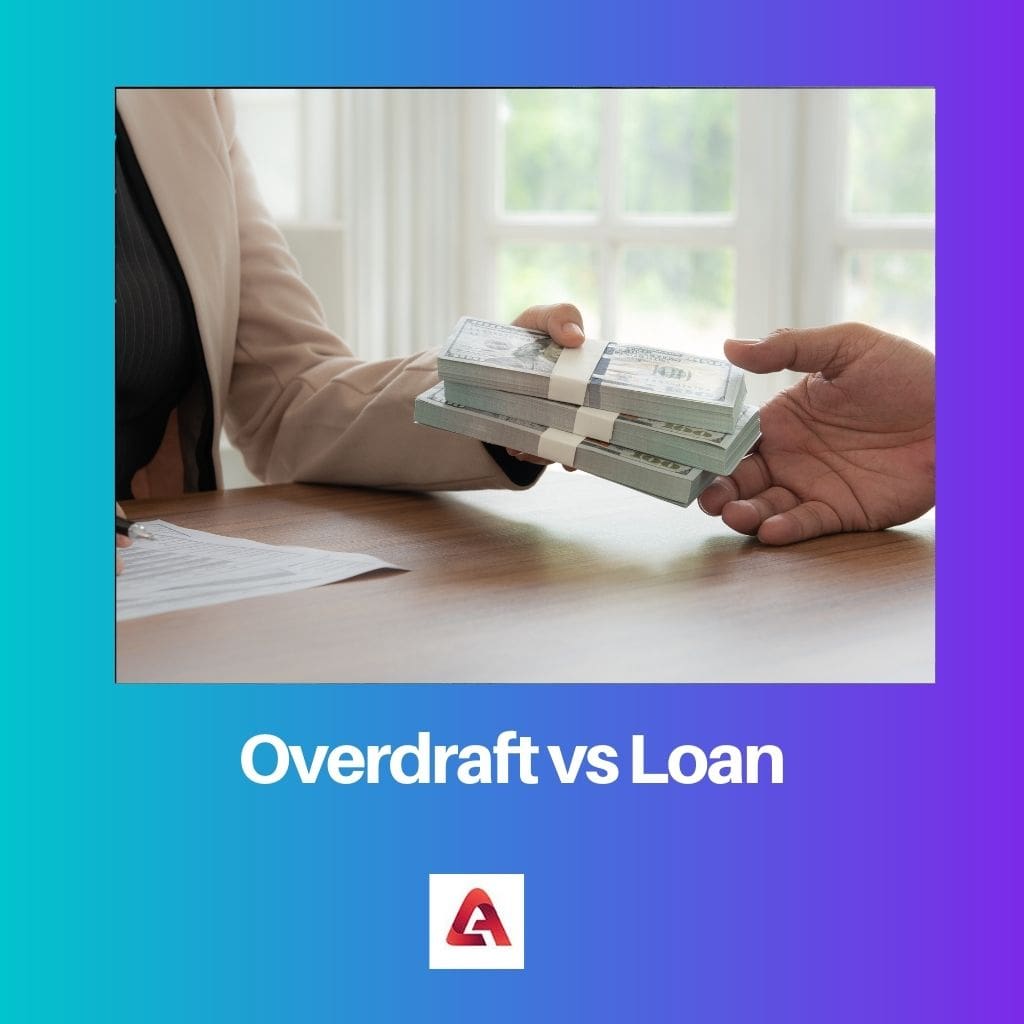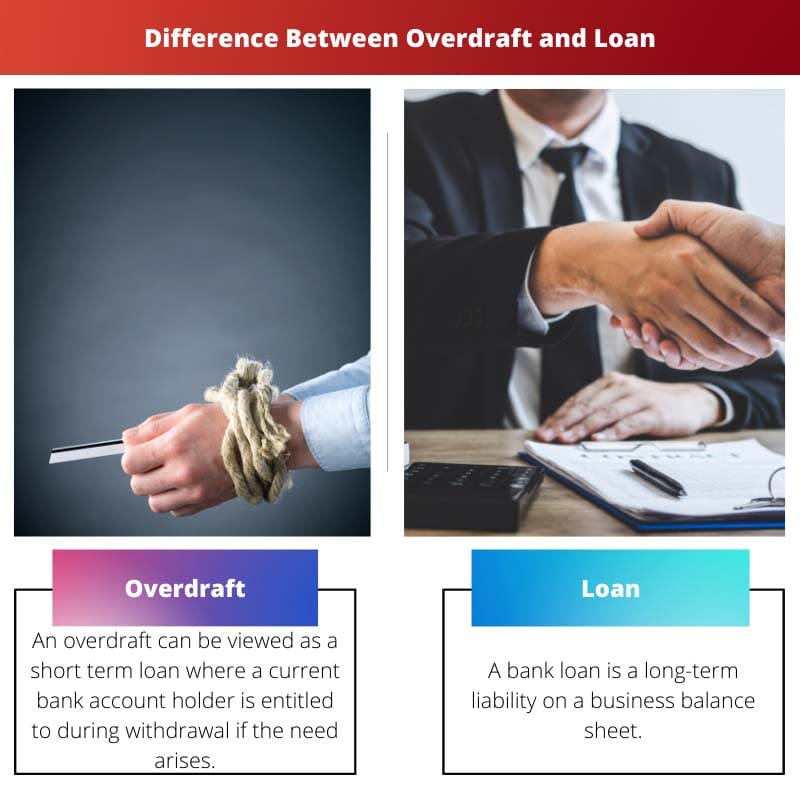An overdraft is a flexible credit facility linked to a current account, allowing account holders to withdraw more money than they have, subject to a predetermined limit, with high interest rates. In contrast, a loan provides a lump sum of money upfront, with fixed repayment terms and interest rates, suitable for specific purposes such as buying a house or a car, involving a formal application process.
Key Takeaways
- Overdrafts provide short-term access to borrowed funds through a bank account, while loans involve borrowing a fixed amount for a predetermined period.
- Interest rates for overdrafts can be higher than loans, making them costlier for long-term borrowing.
- Overdrafts offer flexible repayment with no fixed schedule, whereas loans have a structured repayment plan.
Overdraft vs Loan
An overdraft is a short term loan in which the bank account holder can withdraw a larger amount than their present bank account amount. A loan is a borrowed amount of funds or capital that a bank or financial institution lends to an organization or individual for a specific time.

Comparison Table
| Feature | Overdraft | Loan |
|---|---|---|
| Definition | A credit facility linked to a checking account that allows you to withdraw more money than you have available, up to a pre-approved limit. | A fixed sum of money borrowed from a lender, which you repay with interest over a set period. |
| Purpose | Short-term, unexpected expenses, cash flow gaps. | Varied – can be for short-term or long-term needs, such as a car purchase, home improvement, or education. |
| Amount | Pre-determined limit, smaller than loans. | Varies depending on the type of loan and your creditworthiness. |
| Approval process | Generally faster and simpler than applying for a loan. | More involved process, requiring credit checks and documentation. |
| Repayment | Flexible – you can repay any amount, anytime, within the agreed timeframe. Interest is charged only on the amount used. | Fixed monthly installments, with interest calculated on the total loan amount. |
| Interest rates | Typically higher than most loan rates, charged daily on the used amount. | Varies depending on the loan type, creditworthiness, and repayment term. Generally lower than overdraft rates. |
| Fees | May include monthly maintenance charges, overdraft usage fees, and returned item fees. | May have origination fees, prepayment penalties, and late payment fees. |
| Overall cost | Can be expensive due to high interest rates and potential fees, especially if not managed carefully. | Can be a cost-effective option for larger expenses, especially if you qualify for a lower interest rate. |
| Impact on credit score | May not directly impact your credit score unless you consistently go over your limit or default on repayments. | Can affect your credit score, both positively (on-time payments) and negatively (missed payments, high utilization). |
What is Overdraft?
An overdraft is a financial service provided by banks and credit unions that allows an account holder to withdraw funds from their current account even if the available balance is insufficient to cover the withdrawal. It essentially extends credit to the account holder, allowing them to borrow money up to a predetermined limit.
How Does an Overdraft Work?
- Pre-Approved Limit: Before utilizing an overdraft, the account holder must have a pre-approved overdraft limit set by the financial institution. This limit is determined based on factors such as the individual’s credit history, income, and banking relationship.
- Flexible Borrowing: Account holders can withdraw funds beyond their available balance, up to the specified overdraft limit. This provides flexibility in managing cash flow and covering unexpected expenses.
- Interest and Fees: Overdrafts incur interest charges and fees. Interest is charged on the amount overdrawn, and fees may apply for each transaction that exceeds the available balance. These charges can vary depending on the financial institution and the terms of the overdraft agreement.
- Repayment: The overdraft must be repaid within a specified period, with interest. Repayment terms can vary, but typically, account holders are required to bring their account balance back to positive within a certain timeframe to avoid additional fees or penalties.
Benefits of an Overdraft
- Convenience: Overdrafts provide immediate access to funds, offering a convenient solution for short-term cash needs or emergencies.
- Flexibility: Account holders have the flexibility to borrow only what they need, up to their approved limit, without the need for a formal application process.
- Risk Management: Overdrafts can act as a safety net, helping account holders avoid declined transactions or bounced checks, which could result in additional fees or damage to their credit.
Considerations and Risks
- Cost: Overdrafts can be expensive, with interest charges and fees adding up quickly, especially if the overdraft is not repaid promptly.
- Impact on Credit Score: Constantly relying on overdrafts without timely repayment can negatively impact credit scores and financial stability.
- Dependence: Overuse of overdrafts may lead to a cycle of debt and reliance on borrowed funds, potentially exacerbating financial challenges in the long run.

What is a Loan?
A loan is a financial instrument where a lender provides funds to a borrower, with the expectation of repayment along with interest over a defined period. Loans are commonly used for various purposes, such as purchasing a home, financing education, or covering business expenses.
Types of Loans
- Secured Loans: Secured loans are backed by collateral, such as a home or car. If the borrower fails to repay the loan, the lender can seize the collateral to recoup their losses. Mortgage loans and auto loans are common examples of secured loans.
- Unsecured Loans: Unsecured loans do not require collateral. Instead, lenders assess the borrower’s creditworthiness based on factors such as credit history, income, and debt-to-income ratio. Personal loans and credit cards are examples of unsecured loans.
- Fixed-Rate Loans: Fixed-rate loans have a constant interest rate throughout the loan term, providing borrowers with predictable monthly payments. This type of loan is ideal for those who prefer stability and want to avoid fluctuations in interest rates.
- Variable-Rate Loans: Variable-rate loans have interest rates that can change over time, tied to an index such as the prime rate. While initial rates may be lower than fixed-rate loans, borrowers face the risk of higher payments if interest rates rise.
How Do Loans Work?
- Application and Approval: To obtain a loan, borrowers submit an application providing personal and financial information. Lenders evaluate the application, including credit history and income, to determine eligibility and the terms of the loan.
- Funding: Once approved, the lender disburses the loan amount to the borrower, either as a lump sum or in installments, depending on the loan type and terms.
- Repayment: Borrowers are required to repay the loan according to the agreed-upon terms, which may include monthly payments over a fixed period. Payments consist of both principal and interest, with a portion of each payment applied to reducing the outstanding balance.
- Interest: Lenders charge interest on the loan amount as compensation for providing funds. The interest rate may be fixed or variable, depending on the loan agreement.
Benefits of Loans
- Access to Funds: Loans provide borrowers with access to funds they may not have immediately available, allowing them to make large purchases or investments.
- Structured Repayment: Loans have structured repayment plans, making it easier for borrowers to budget and manage their finances.
- Building Credit: Responsible repayment of loans can help borrowers establish or improve their credit history, which can be beneficial for future borrowing and financial opportunities.
Considerations and Risks
- Debt Obligation: Loans represent a financial obligation that must be repaid according to the terms of the agreement. Failure to repay the loan can result in penalties, damage to credit, and potential legal action.
- Interest Costs: Borrowers pay interest on the loan amount, which increases the total cost of borrowing. Higher interest rates or longer loan terms can result in higher overall costs.
- Risk of Default: Defaulting on a loan can have serious consequences, including damage to credit and potential loss of collateral for secured loans.

Main Differences Between Overdraft and Loan
- Nature of Transaction:
- Overdraft: Allows account holders to withdraw more money than they have in their current account, up to a predetermined limit.
- Loan: Involves borrowing a lump sum of money upfront, with a specific purpose, such as purchasing a home or financing education.
- Repayment Structure:
- Overdraft: Repayment is flexible, as account holders must bring their account balance back to positive within a certain timeframe to avoid additional fees or penalties.
- Loan: Repayment terms are fixed, with borrowers making regular payments over a specified period, consisting of both principal and interest.
- Interest and Fees:
- Overdraft: Typically incurs high interest rates and fees, charged on the amount overdrawn and per transaction that exceeds the available balance.
- Loan: Involves interest charges applied to the total loan amount, with rates depending on factors such as creditworthiness, loan type, and market conditions.
- Purpose and Usage:
- Overdraft: Suited for short-term cash flow needs or emergencies, providing immediate access to funds.
- Loan: Used for specific purposes, such as purchasing assets or making investments, involving a formal application process and structured repayment plan.
- Risk and Impact:
- Overdraft: Can lead to a cycle of debt if overused, negatively impacting credit scores and financial stability.
- Loan: Carries the risk of default if repayments are not made as agreed, potentially resulting in damage to credit and loss of collateral for secured loans.
- Approval Process:
- Overdraft: Pre-approved overdraft limits are determined based on factors such as credit history, income, and banking relationship.
- Loan: Requires a formal application process, with lenders assessing the borrower’s creditworthiness and financial stability before approval.




